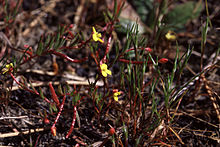| Camissonia strigulosa | |
|---|---|

| |
| Conservation status | |
 Apparently Secure (NatureServe) | |
| Scientific classification | |
| Kingdom: | Plantae |
| Clade: | Tracheophytes |
| Clade: | Angiosperms |
| Clade: | Eudicots |
| Clade: | Rosids |
| Order: | Myrtales |
| Family: | Onagraceae |
| Genus: | Camissonia |
| Species: | C. strigulosa |
| Binomial name | |
| Camissonia strigulosa (Fisch. & C.A.Mey.) P.H.Raven | |
Camissonia strigulosa is a species of flowering plant in the evening primrose family known by the common name sandysoil suncup.
The plant is native to California and Baja California, where it grows in sandy areas, such as beaches, mountain sandbars, and the Mojave Desert.
Description
Camissonia strigulosa is an annual herb with a tough, slender, hairy stem which may grow erect or lie along the sand. It approaches 50 centimeters in maximum length and is lined with small, thin green to red linear leaves with tiny bumpy teeth along the edges.
The flower has four yellow petals a few millimeters long which may have red spots near the bases.
The fruit is a long, very thin podlike capsule containing tiny seeds.
References
- "NatureServe Explorer - Camissonia strigulosa". NatureServe Explorer Camissonia strigulosa. NatureServe. 2022-05-30. Retrieved 30 May 2022.
- "Quino Checkerspot Butterfly Habitat Assessment for the Tule Wind Project" (PDF).
- "Santa Monica Mountains National Recreation Area".
- "Plant Profile_USDA NRCS".
External links
[REDACTED] Media related to Camissonia strigulosa at Wikimedia Commons
| Taxon identifiers | |
|---|---|
| Camissonia strigulosa |
|
| Sphaerostigma strigulosum | |
This Myrtales article is a stub. You can help Misplaced Pages by expanding it. |
- NatureServe apparently secure species
- Camissonia
- Flora of Baja California
- Flora of California
- Flora of the Sierra Nevada (United States)
- Flora of the California desert regions
- Natural history of the California chaparral and woodlands
- Natural history of the California Coast Ranges
- Natural history of the Channel Islands of California
- Natural history of the Mojave Desert
- Natural history of the Peninsular Ranges
- Natural history of the San Francisco Bay Area
- Natural history of the Santa Monica Mountains
- Natural history of the Transverse Ranges
- Myrtales stubs